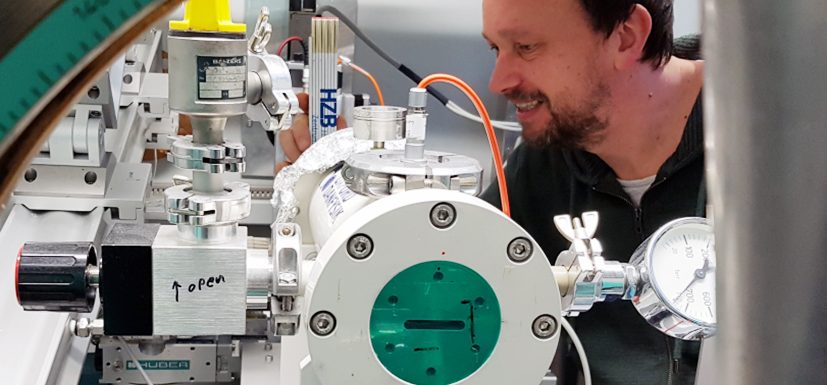
What’s the name of your beamline and what’s it like?
I am working on two dipole beamlines, the KMC-2 and the KMC-3, where I am in charge of the XANES end-station at the KMC-2 and the CryoEXAFS end-station at the KMC-3. Both beamlines are operated with a Si 111 monochromator, which allows energy scans to be performed so that the X-ray absorption fine structure (XAFS) can be investigated on a variety of samples. The KMC-2 is one of the workhorses of the BESSY II. It has been in use for a long time, we have put a lot of effort into its improvement and it has really proven its value. It allows for a variety of in-situ experiments due to its flexible construction. The CryoEXAFS, which is operated together with the FU-Berlin, has been in regular user operation for a few years only and several improvements to its set-up are planned.
For which research applications is this beamline especially well-suited?
At the KMC-2 XANES end-station, many experiments on energy materials are carried out. Especially important are in situ and in operando XAFS measurements of battery cells to develop new cathode materials for batteries. The KMC-3 CryoEXAFS is particularly suitable for time-resolved in situ X-ray absorption measurements. This allows for example the catalysis of water oxidation to be investigated. Catalysis of water oxidation is crucial not only in biological photosynthesis, but also in technology for production of non-fossil fuels.
What’s your background, scientifically? How did you get to be a beamline scientist?
I am a natural scientist and studied mineralogy at the TU-Berlin, specialising in crystallography. In my doctoral thesis and in my postdoctoral period at the ETH Zurich, I focused on the combination of crystallography and spectroscopy, so that I got more and more involved in experimental solid state physics. After some time as an application scientist in industry, I got the great opportunity to contribute my previous scientific experience as a beamline scientist at the HZB.
What is your work as a beamline scientist? (Or: What are you doing “all day”?)
The main part of my work as a beamline scientist consists of supporting users in their experiments on BESSY II and planning and arranging user experiments. I prepare the respective measurement set-up and coach inexperienced users in how to operate the end-stations. Ideally, we can carry out optimisations and initial evaluations after the first measurements. In addition, the entire equipment and software must be continuously maintained and improved. We receive way more applications for beam time at my two end-stations than we can cover. The other part of my job is dedicated to my own research, where I focus on hybrid perovskites.
“The high degree of interdisciplinarity is a big challenge, but also a great source of scientific development opportunities. It is very rewarding when, after many hours at the beamline, exciting scientific results and publications can be achieved together with the users”
What is your biggest challenge in working with the beamline?
The users often come from very different scientific fields and conduct research on very different scientific topics. In such an interdisciplinary scientific environment, it is exciting and challenging at the same time to find common scientific points of reference to start from. We always strive for our guests to achieve the best possible results during their allocated measurement time, which can be difficult when they use our methods for the very first time and so an additional challenge is the continuous improvement of the existing beamline infrastructure.
What is the most rewarding part?
The high degree of interdisciplinarity is a big challenge, but also a great source of scientific development opportunities. It is very rewarding when, after many hours at the beamline, exciting scientific results and publications can be achieved together with the users. When it comes to new issues that need to be solved, there are always other HZB staff members available for help. Being part of a strong team gives the necessary support for the daily challenges at the beamline.
What are you working on at the moment?
Currently, I am working on the evaluation of temperature-dependent EXAFS data from various hybrid perovskites measured at the KMC-2 XANES end-station. The behaviour of the EXAFS Debye-Waller factors allows drawing conclusions about the interaction of the more or less rigid lead iodide cage and the highly dynamic organic molecule groups which are connected to the surrounding inorganic structure by hydrogen bonds. The first results are promising and are in conformance with my previous spectroscopic work on these materials. The KMC-2 XANES has recently been equipped with a new cryostat which was developed and implemented by the sample environment group here at the HZB. The cryostat made my measurements possible in the first place. Our own research is a driving force for the further development of the existing beamline infrastructure. We as beamline scientists are at the source of this and can be the first to benefit from such developments.
What have you always wanted to tell people about beamline work?
The supply and advancement of our measurement capabilities here at the BESSY II synchrotron is an exciting and fulfilling task which is perceived very positively by our measurement guests. For me, this is a great motivation and gives me many opportunities for scientific development. Working as a beamline scientist comes with daily new challenges. Mastering these challenges helps strengthening my own expertise and that of colleagues in the team. It is key to a rewarding measuring time for our guests and to strong scientific results in my own research.
